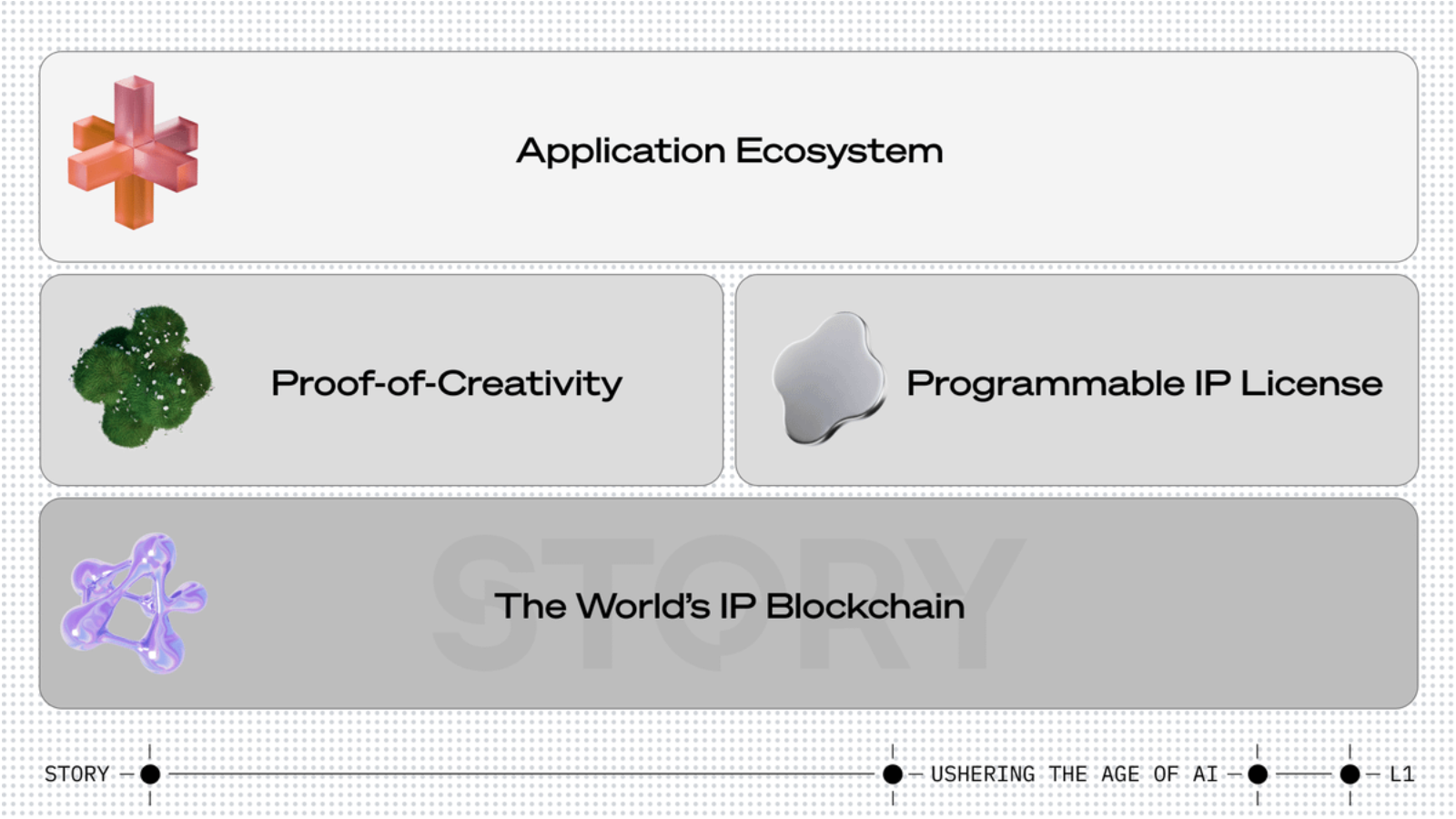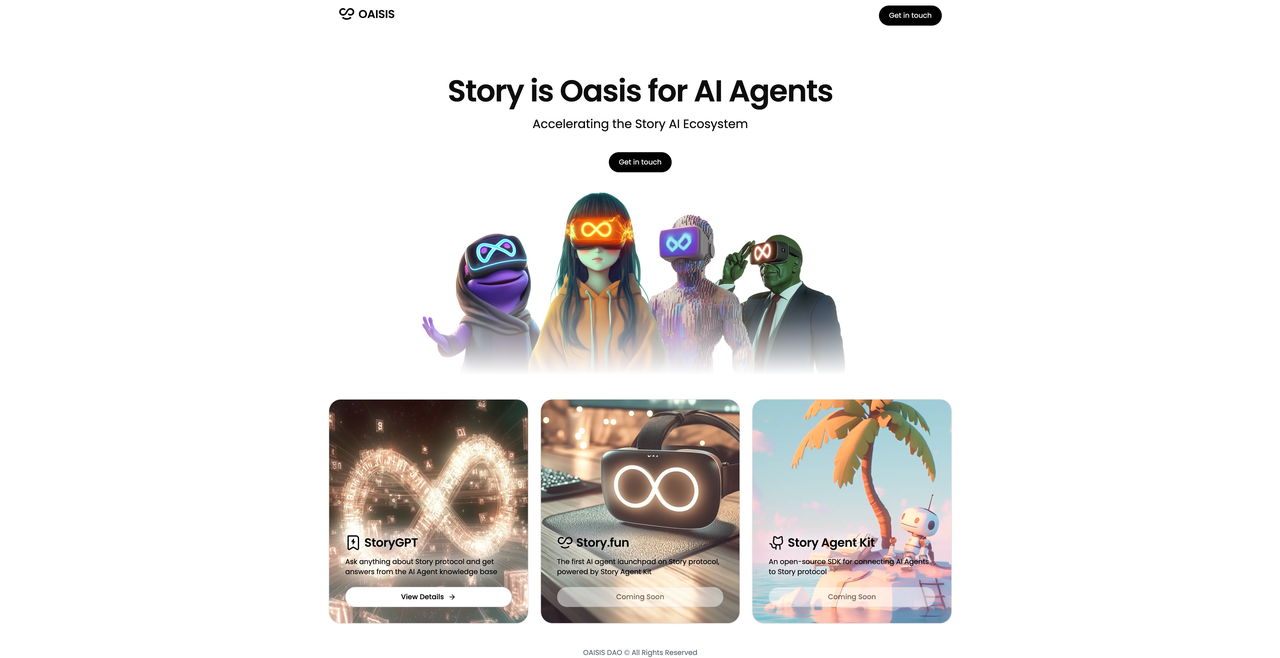Driven by AI + empowered by blockchain, how does Story reshape traditional IP market rules?

Reprinted from panewslab
01/21/2025·3MIn traditional intellectual property management, content creators usually rely on traditional platforms to display their works. However, these platforms often profit from them through opaque revenue distribution mechanisms, making it difficult for them to obtain fair value in content creation.
Creators face multiple challenges: First, it is difficult to protect rights, and creators often find it difficult to prove the source of their rights. The off-chain process is cumbersome and lacks transparency; second, income distribution is unfair, and the income from a large number of IP derivatives cannot be accurately returned to the original creator; Finally, the authorization process is complex, and manual negotiations and paperwork consume a lot of time and effort.
In order to solve these problems, Story Protocol provides a decentralized way to change the interaction between content creators and consumers, using blockchain technology to ensure the ownership, transparency and fair distribution of content, so that creators can focus on Creativity itself.
1. What is Story?
story protocol - Introducing global intellectual property blockchain
Story is a purpose-built layer 1 blockchain designed for intellectual property. It can tokenize any type of IP; whether it’s ideas, images, real-world assets, songs, AI models, NFTs, image rights, or anything in between. Story provides a transparent, decentralized solution for IP management by embedding terms of use, attribution and royalty agreements directly into the blockchain. This enables IP holders to protect their work, collaborate seamlessly, and unlock greater revenue opportunities in an AI-driven economy.
Project background
Story Protocol was founded by Jason Zhao, Seung Yoon Lee and Jason Levy, and the team behind it brings together experts in Crypto, intellectual property and AI technology. In addition, three rounds of large-scale financing have been completed since 2023, with a16z investing in three consecutive rounds, pushing the total financing amount to US$134 million.
2. Story technical architecture and implementation
Story Protocol as a whole is composed of multiple elements: Story network (L1), Creativity Proof Protocol (smart contract) and programmable IP license.

Story Network
Story Network is a purpose-built layer 1 blockchain that implements the best features of the EVM and Cosmos SDK. It is fully compatible with the EVM and has deep execution layer optimization to support graph data structures, and is designed to handle complex data structures such as IP quickly and cost-effectively. Specific implementation methods include:
- Use precompiled primitives: Traverse complex data structures like IP graphs in seconds at marginal cost.
- Consensus layer based on the proven CometBFT stack: ensuring fast finality and low-cost transactions.
creativity protocol
Story’s “Proof of Creativity” protocol introduces a revolutionary open programmable IP layer, elevating IP into a first-class entity in the blockchain ecosystem. At the heart of the system are 🧩 IP assets and their associated IP accounts, a smart contract designed to serve as the core identity for each IP. This account-centric approach enables the storage and management of IP-related data, as well as the execution of various functions through 🧱 modules to manipulate this data.
Modules are customizable smart contracts used to define and extend the functionality of IP accounts. Modules enable developers to create functionality and interactions for each IP, making the IP truly programmable.
Owners of IP assets can set terms for their IP, and creators of derivative works can then seamlessly extend their work by minting “licensed tokens” (outlined under the terms and represented as NFTs themselves), leveraging the royalty module to generate Create revenue streams from derivative works, or file disputes through the Dispute module.
Programmable IP License (PIL)
PIL is a true off-chain legal contract that defines certain licensing terms and stipulates how IP assets can be legally licensed. For example, how IP assets are commercialized or remixed, and who is allowed to do so and under what conditions.
Although on-chain, the terms of the IP assets and minted licensed tokens are enforced by an off-chain legal contract called a Programmable IP License (PIL). This contract allows anyone to transfer tokenized IP to off-chain legal systems. More specifically, the aforementioned IP assets and modules are the means to automate and on-chain the execution of these terms, thereby creating a mapping between the legal world (PIL) and the blockchain. Just as USDC supports fiat currency exchange, PIL also supports IP redemption.
3. Story Protocol’s latest project progress
Technology development progress:
Architecture design completed: Story Protocol’s basic technical architecture has been completed, and the core team is conducting in-depth testing and optimization to ensure the stability and security of the platform.
Smart contract development: Smart contracts are being developed for intellectual property management. These contracts will handle key functions such as content creation, royalty distribution, and copyright management.
Testnet has been launched:
Test network: Story Protocol recently released a test network (Testnet) for developers and community members to test the protocol functions. This stage will allow users to submit feedback to improve various modules of the system and ensure that the platform reaches its optimal state before it is officially launched.
Next steps:
It is expected that the Story Protocol mainnet will be launched and a beta version of the content creation platform will be launched to encourage creators to actively participate.
Latest news:

Story Protocol plans to launch TCP/IP for AI agents with the aim of building a trading market between AI agents. Since countless AI agents will be generated on the chain in the future, these AI Agents will need to interact and trade with each other. Story plans to integrate ai16z's Eliza and Virtual's GAME framework, etc., with the aim of allowing all Agents to trade IP assets with each other in the future.
4. Challenges faced by Story Protocol
In the process of promoting changes in intellectual property management and content creation, Story Protocol faces a series of major challenges, which will not only restrict the speed of its development, but may also affect the overall success of the project. Here are the main challenges analyzed from several key perspectives:
1) Difficulty in integrating existing IP
In the move to decentralization, integrating existing intellectual property (IP) will be a difficult task. Especially on the Web2 platform, creators usually need to sign an agreement to transfer some of their rights and interests to the platform when registering. This approach goes against Story Protocol’s goal of ensuring creators have complete control over their content and revenue distribution. Therefore, how to gain the trust of existing creators and encourage them to migrate to new platforms is a challenge that Story Protocol must face. Creators may be wary of moving to a new decentralized platform if they are accustomed to the convenience and security provided by their existing platform.
2) The interaction between the ecosystem and real laws
To realize the full potential of Storey Protocol, the mechanisms within the ecosystem must take into account how to effectively interact with the real-life legal system. Although Story Protocol provides a transparent and decentralized solution for IP management through smart contracts and blockchain technology, this does not mean that it can completely replace the traditional legal framework. When intellectual property disputes or violations occur, how to ensure that these legal provisions are executed on the chain and connected with actual laws will be a major challenge it faces.
3) Mechanism design challenges from the creator’s perspective
From a creator's perspective, another challenge that Story Protocol needs to face is its mechanism design, especially the reward mechanism. In the Web2 platform, content homogeneity is serious, and this problem may also reappear in Story Protocol. If the content among creators on the platform lacks differentiation, users' enthusiasm for participation will be reduced, ultimately affecting the quality of the content and the rationality of rewards. Therefore, Story Protocol needs to design a differentiated incentive mechanism to encourage diverse creation and promote the production of innovative and unique content.
Conclusion
Story Protocol is committed to providing content creators with a safer and more transparent intellectual property management and revenue mechanism by introducing the global intellectual property blockchain. The construction of public chains, the introduction of programmable IP licenses, and decentralized content governance provide unprecedented protection and opportunities for content creators and users. Although challenges remain, Story Protocol is expected to play an important role in the future market as the demand for decentralized content platforms continues to grow. By adhering to technological innovation, market sensitivity and legal compliance, Story Protocol will promote the sustainable development of the digital content economy and redefine the management of intellectual property and content creation.



 chaincatcher
chaincatcher